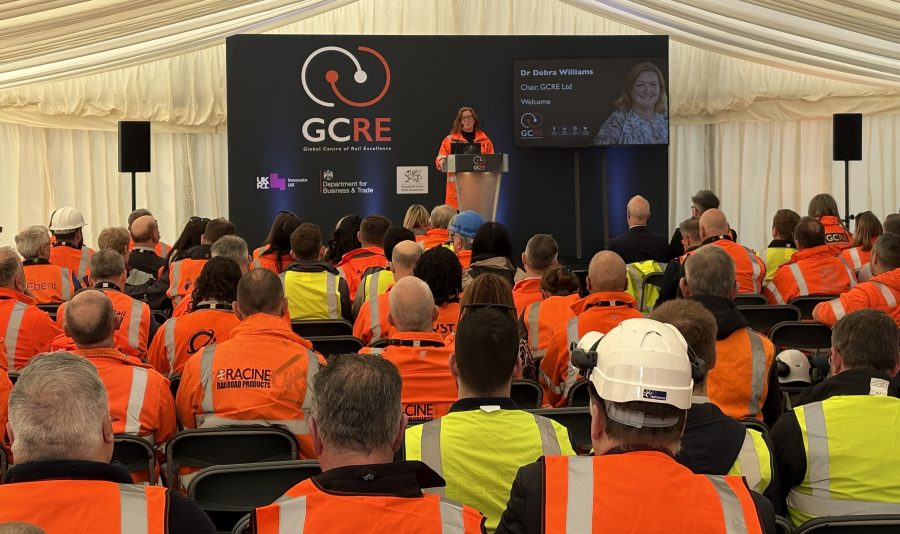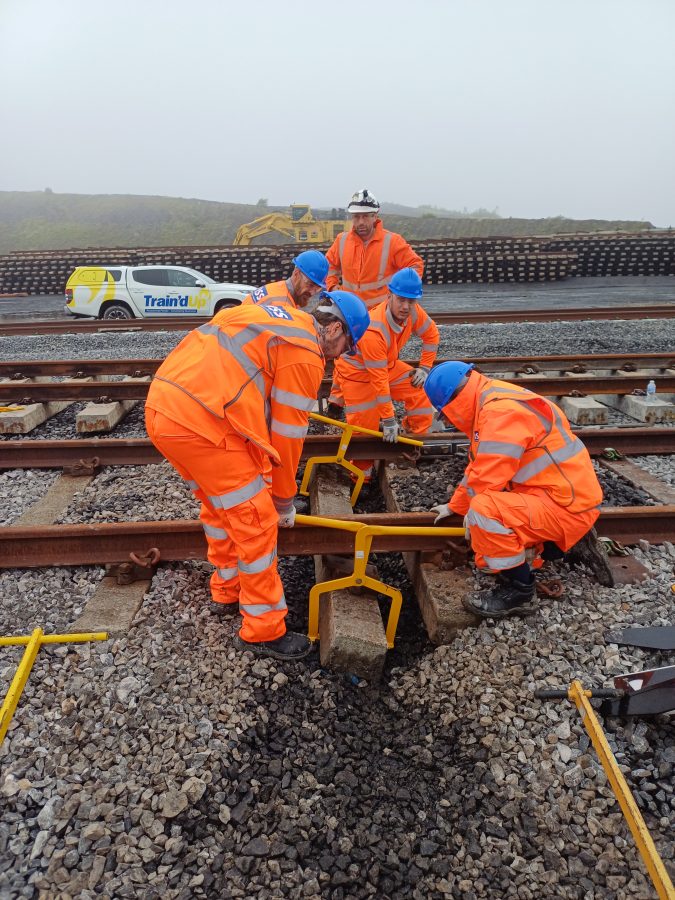GCRE Summer Update
Simon Jones, Chief Executive GCRE Ltd
Working on any large infrastructure project always requires adaptability. The path from design to delivery is never an easy or a linear one. You need a strong and detailed plan, of course, but you also need to know how to respond when conditions change. You need to work with partners and react flexibly when obstacles block your path and, critically, the team that work with you need grit and resilience to see the plan through from design to delivery.
Those things have certainly been true for us here at the Global Centre of Rail Excellence.
A lot has happened since we began the GCRE project in 2017 – a global pandemic; above trend interest rates and inflation; an uncertain and challenging post-Brexit investment landscape have certainly given us things to adapt to! But importantly, what sustains the team at GCRE is the knowledge that they work on something that, creative as it is, isn’t just another rail project.

Yes, GCRE will provide both the UK and Europe with the first ever, purpose-built facility for both rolling stock and rail infrastructure research, testing and innovation. At a time when so much investment is being committed toward rail infrastructure, it’s more vital than ever that there are adequate facilities for the testing and development of technology and systems that can underpin its effective delivery. Crossrail and HS2 are perhaps the two best examples of where the rail industry can – and must – do better to deliver projects more reliably and cost-efficiently and in GCRE Wales will have an asset of strategic national significance to help the industry tackle some of those issues.
However, the real prize for Wales is that GCRE will help give coalfield communities in South West Wales a stronger economic platform on which to stand. A place once known around the world for the world class anthracite it mined, could in the coming years become known as an international leader in net zero rail innovation. What GCRE offers is the chance to develop not only stronger and more diverse business foundations in the region, but also a new pride and identity in its own economic future. In that sense, GCRE will have a social and economic resonance well beyond what can be measured.
GCRE has the potential to create more than 1,100 long-term, high-quality jobs in its first decade and become a magnet for other, high-quality investments. A recent economic appraisal by PWC highlighted that GCRE was a ‘very high’ value for money project that has the potential to create contribute £300m GVA uplift to the local economy over the next ten years and £1.2bn over its lifetime. It said that for every £1 spent on developing the GCRE project, £15 is returned in wider community, economic and rail industry benefits.
GCRE was conceived back in 2017 as a new way to think about – and to deliver – economic growth in a heads of the valleys area. It was designed to become a new magnet for R&D and stimulate new business creation and entrepreneurship in a coalfield community where the private market, left to its own devices, would not naturally look to invest.
In that time we have made important progress. We’ve used our seed funding from government to find and purchase a fantastic site; we’ve got planning permissions in place so that we are shovel-ready, with a three-year build timeline as soon as investment can be secured. The project has developed in scope since it was originally conceived, but that has been as a result of attempting to harness the positive and complementary opportunities that exist on the site for growth and jobs.

Importantly, we’ve built industry-wide commercial interest and momentum in the facility we are developing. A recent £7.4m Innovate UK competition funded by the Department for Business and Trade in the UK Government has seen companies innovating products on site, with some of the teams gaining international interest in their technologies; signing new contracts; creating new jobs and even securing equity investment in their companies. More than 200 companies have endorsed the project, one fifth of which are headquartered outside the UK.
The aim of that development work has been to de-risk the GCRE project to a point where private investors could be attracted in to finance the bulk of construction and, ultimately, take forward a business which could act as a new economic magnet for the region. Our intention is to operate GCRE as a successful business, but it’s also an opportunity to show how that can be done creatively, working with government and industry partners in an active way.
We knew how challenging the task would be. It has never been easy to attract major sources of private investment to northern areas of the South Wales valleys and GCRE is a development not without risk. Looking back, our biggest barrier was that we began our search at the very time when the UK’s economic headwinds were at their strongest. The last few years gave been a challenging time for every major project looking for large scale capital funding.
As I indicated in January, initial feedback from investors was that while they applauded the vision and could see the strategic need for such a facility, the construction and early years commercial revenue risks of GCRE still remained the biggest barriers to commitment. Despite international interest from both the Middle East and the US; from the rail and the energy sectors, we still have not secured the funding we need.
As a result, GCRE has taken longer to move towards the construction phase than we had originally intended. In recent months that has led to some challenging headlines about the delay to the project and questions about the ultimate viability of the project. There’s no hiding from the fact that this isn’t where we wanted to be. But I also know from my own background in major projects – that’s not unusual. Particularly for a development as large, as complex and as novel as GCRE is. One thing I know for sure, though, the prize is worth it. We must find ways to grow the economy in Wales, particularly in de-industrialised areas of the country and GCRE is still one of the most interesting and creative, home-grown ways in which we can do that.

We remain positive, for several important reasons. The first and foremost is that we are still in discussions with potential investors. Now with the support of Welsh Government, we are exploring additional ways in which we can get investment secured and that work will continue in the coming weeks. This includes looking at ways to further de-risk the capital construction of the project and underpin the early years revenue risk of the facility.
Second, the opportunities for the GCRE site when it is built only continue to grow. Most recently, we have had seen new and active interest from Data Centre and energy developers who see significant potential in the site to locate new infrastructure that will help make the facility a commercial success. The UK – like most countries – needs more large sites on which to develop new infrastructure of this kind and with GCRE located on a site as large as Gibraltar, it’s one of the complementary ways in which we can show a strong commercial return on the investments made at GCRE.
Third, the economic and social imperative of getting more projects like GCRE to succeed only grows with time. Everyone is heartened to see that work has now begun constructing the new electric arc furnace at Tata in Port Talbot. But there is no escaping the fact that the site will employ fewer people than it did in the past and that many thousands of jobs are being lost as a result of the transition across the supply chain. The UK Climate Change Committee recently reported that more needed to be done to create alternative forms of employment in the region.
We are doing our bit, recently beginning a new skills training pilot on the GCRE site to support 72 former Tata steelworkers and those impacted in the supply chain to help them take up new employment opportunities in the rail industry. The first cohort have now finished their training and have already started in good quality, well-paid jobs. The opportunity for GCRE and its partners to directly employ many more is one that is tantalisingly close if we can secure the investment we need to build the full GCRE site.

The UK Government has certainly shown through its new Industrial Strategy that investment in new, place-based infrastructure is vital not only to kick starting economic growth, but to building greater resilience in coalfield communities. Using the net zero revolution to help give deindustrialised areas a new economic future has never been more vital – and an important part of the next few months will be seeing what more UK Government can do to support the Welsh Government’s investment choices at GCRE.
What sustains the team at GCRE is the firm belief that the project is a transformational one – something that will help to rebuild local prosperity in an area of the South Wales coalfield through the creation of new jobs, identity and pride for this and future generations. The task isn’t easy, but we’ll keep working flexibly with our partners to achieve that goal.